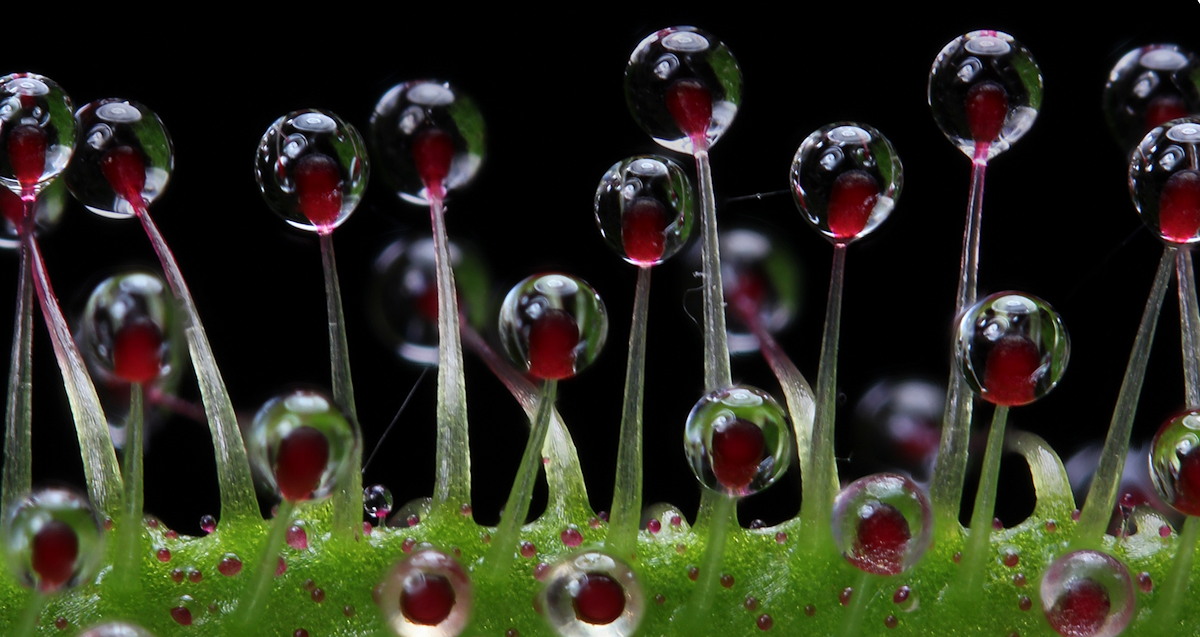
Drosera regia
Carnivorous plants have six basic trapping mechanisms (with representative genera or species):
- Adhesive
- Flypaper (Pinguicula)
- Fixed tentacles (Byblis, Drosophyllum, Roridula, Triphyophyllum)
- Mobile tentacles (Drosera)
- Pitfall
- Open with pool of water (Nepenthes, Heliamphora, Cephalotus, Brocchinia, Catopsis, Sarracenia purpurea and S. rosea)
- Covered or no pool of water (most Sarracenia, Darlingtonia)
- Lobster pot (Darlingtonia, Sarracenia psittacina)
- Pigeon trap (Genlisea, Sarracenia psittacina)
- Snap (Dionaea, Aldrovanda)
- Suction (Utricularia)
Some complex traps have multiple mechanisms.
The simplest trapping mechanism is the adhesive trap. The flypaper-like leaves of Pinguicula have specialized short stalked glands that secrete a sticky mucilage that traps small creatures. The glands are stalked so the leaf itself doesn't smother in slime while it waits for a prey.
The adhesive trap leaves with tentacles are similar in function to the flypaper-like leaves except tentacles provide a longer grasp to snag any passer-by. The resinous mucilage of Drosophyllum, Roridula, and Triphyophyllum works well in dry and extremely wet environments. The thinner mucilaginous tentacles of Byblis and Drosera function well in damp boggy environments. Drosophyllum, Roridula, Triphyophyllum, and Byblis tentacles do not move and function purely as a trapping mechanism. Except for Roridula they have separate glands on the leaf surface that secrete digestive enzymes in a thinner mucilage. Roridula relies on assassin bugs to do its digestion. Drosera tentacles are multifunction. They snag prey, move to bring as many tentacles as possible into contact with the prey and smother it in slime, and release digestive enzymes. The tentacles as well as the glands on the leaf suface absorb the nutrients from the prey.
Pitfall traps are leaves modified into pit-like structures. The Bromeliad carnivores (Brocchinia and Catopsis) are the simplest pitfall traps where the base of the whorl of leaves seal to form a cup to catch water. Prey slip down the leaves into the pool at the base and drown. The other carnivores with pitfall traps have highly modified leaves where each leaf is a separate trap. The traps may have nectaries, bright colors, or a flower-like scent to attract prey. The traps may have hairs to direct prey to the trap opening or cause the prey to fall into the trap. The lip of the trap is usually slippery and the inside of the trap waxy. The open pool traps have pools of water to drown victims. The tall, thin Sarracenia traps have only a small amount if any free water and essentially starve their prey to death. Most of the pitfall traps have hoods to exclude rain. The plant determines the amount of water in the trap and will pump it in or out as necessary. The leaves may also adjust the pH of the water and release digestive enzymes.
Darlingtonia and Sarracenia psittacina have a trap similar to the traps used to catch lobsters. A lobster pot has an entrance prey can easily find on the outside and enter but the entrance is difficult to find or exit from the inside. Once inside, if the prey find the entrance or figure it out they can easily leave. Darlingtonia and Sarracenia psittacina have an opening that is dark while the rest of the trap has light coming in through white cells called areoles. Light orienting prey tend not to find entrance and end up in the pitfall or pigeon trap part of the leaf.
Genlisea plants are found in water or water saturated soil. Its primary prey are protozoans. The prey enter the trap by pushing past inward pointing hairs. Once inside the trap they can not get back out past the hairs. This is the way pigeon traps work except thin metal rods are used instead of hairs. Sarracenia psittacina uses a similar concept where hairs in the neck of the trap allow prey to move only in one direction to you know where.
The most dramatic trap is the snap trap of Dionaea muscipula and Aldrovanda vesiculosa. Pitfall, lobster pot, and pigeon traps are static. Elements of the flypaper traps may move but they move too slowly for humans to perceive the movement in real time. Suction traps move too fast to see the action. But snap traps leave little to the imagination. A prey moves into the trap, brushes against the trigger hairs, and you see the trap very quickly enclose the prey. Unlike hinged snap traps made by humans, this snap trap bends the halves of the trap to enclose the prey. The trap closes by almost explosively expanding the cells on the outer surface of the leaf. You can verify this by noting that before the trap is triggered, each half of the leaf is flat. After being triggered the halves are cupped. The trap will then slowly seal and digest the prey, reopening when it is done.
It has been argued the most complex plant leaf on this planet is the Utricularia suction trap. The traps ready themselves by pumping water out of the sealed trap creating what would be considered a vacuum if air were involved. When triggered, they work so quickly that the highest speed video cameras show the prey outside the trap in one frame and already sucked inside on the next frame. Once inside the prey is digested and the trap rearms itself.
-- John Brittnacher
For a more detailed discussion please see the following articles and articles they reference.
Nolan, Garry (1978) On the Foraging Strategies of Carnivorous Plants: II. Biological Stimulus versus Mechanical Stimulus in the Fast-Moving Periphery Tentacles of the Species Drosera burmanni. Carniv. Pl. Newslett. 7(3):79-81 ( PDF )
Williams, Stephen E. (1980) How Venus' Flytraps Catch Spiders and Ants. Carniv. Pl. Newslett. 9(3):65,75-78 ( PDF ) part 1
Williams, Stephen E. (1980) How Venus' Flytraps Catch Spiders and Ants. Carniv. Pl. Newslett. 9(4):91,100 ( PDF ) part 2
Elzinga, Glenn and John D. Beebe and Randall Van Dragt (1983) A Photographic Study of the Rapid Movement of Stalked Glands of the Cape Sundew Drosera capensis. Carniv. Pl. Newslett. 12(3):69-73 ( PDF )
Katagiri, Yoshiaki (1984) The Leaf Blade Movement of Drosera prolifera. Carniv. Pl. Newslett. 13(2):52-53 ( PDF )
Studnicka, Miloslav (2003) Further problem in Genlisea Trap untangled?. Carniv. Pl. Newslett. 32(2):40-45 ( PDF )
Volkova, Polina A. and Shipunov, Alexey B. (2009) The natural behavior of Drosera: Sundews do not catch insects on purpose. Carniv. Pl. Newslett. 38(4):114-120 ( PDF )
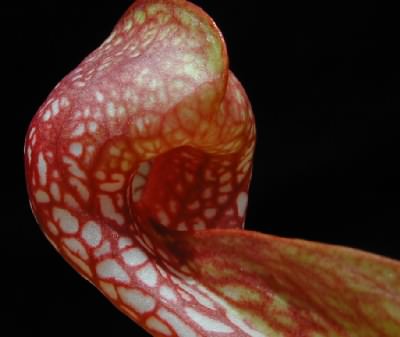
Sarracenia psittacina leaves are complex traps. In the lobster pot part, prey enter the hole in the trap but are unable to find their way out because they orient to the light coming through the white areoles. The trap also has a secondary pigeon trap trapping mechanism where the thin base has overlapping hairs to force prey to only go down the leaf to where they are digested.
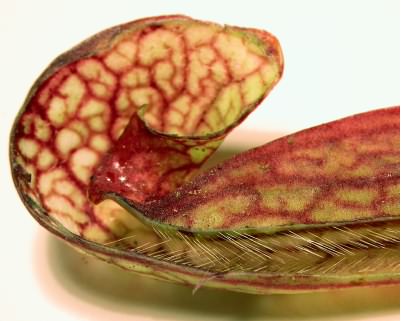
Inside of a Sarracenia psittacina trap slit in half lengthwise. Notice the dark pigmentation around the opening in the lobster pot part of the trap and the inward pointing hairs in the pigeon trap part of the leaf.
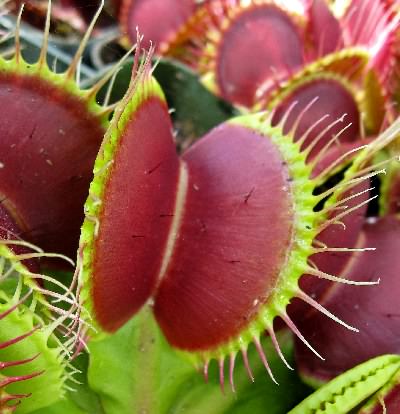
Dionaea muscipula leaf is a snap trap. Notice the three trigger hairs on each half of the inner trap surface. The trap has nectar glands about where the red transitions to green in this trap.
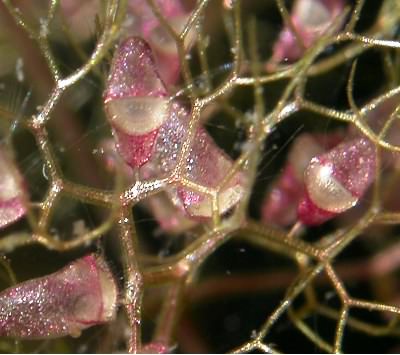
Utricularia inflata suction trap leaves. Utricularia have no roots. What you see the traps attached to are stems. If there are any structures that look like normal leaves, those are modified stems.
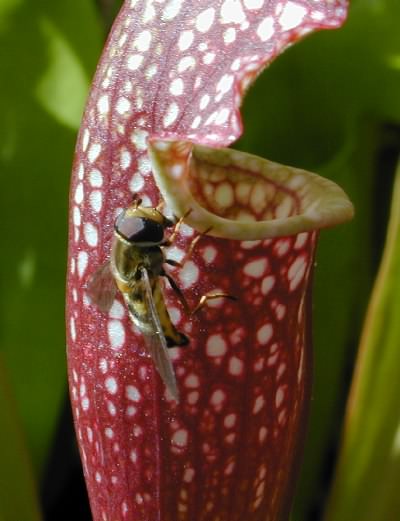
This Syrphid fly is living dangerously. The plant is the hybrid Sarracenia 'Ladies in Waiting' with a typical pitfall trap. The fly is a beneficial insect whose larvae eat aphids and the adults feed on nectar, usually from flowers. Here it is sipping on nectar secreted around the mouth of the trap.
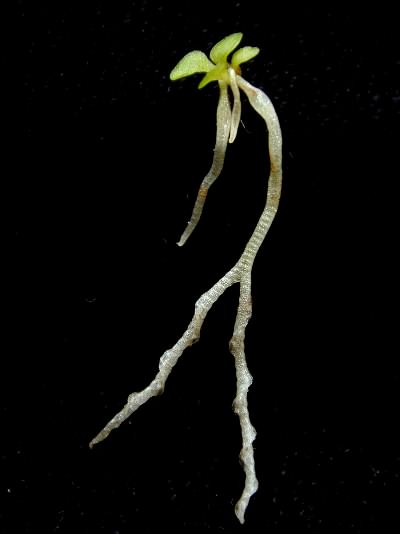
Genlisea violacea seedling showing the fork-shaped pigeon trap. The white trap is actually a highly modified rolled underground leaf. You need a microscope to see the mechanism of the trap. The "stomach" is up near green leaf-like structures.
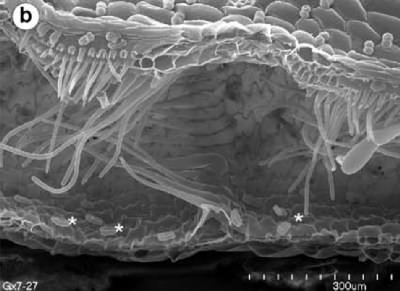
Inside of Genlisea lobata x G. violacea trap slit in half lengthwise. Prey move right to left only. Image from Plachno, J. B., Kozieradska-Kiszkurno, M., Swiatek, P., Darnowski, W. D. (2008) Prey attraction in carnivorous Genlisea. Acta Biol. Cracov., Ser. Bot. 50:87-94.
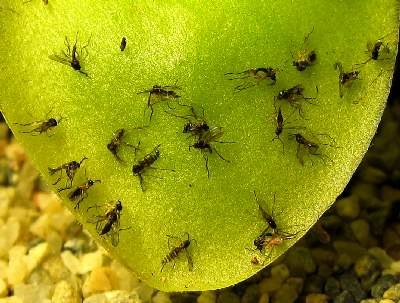
Pinguicula gigantea leaf showing the remains of fungus gnats. This slimy sticky leaf is an example of an adhesive trap. Carnivorous plants usually have proteases to digest protein but don't contain chitinases to digest the exoskeleton of insects.
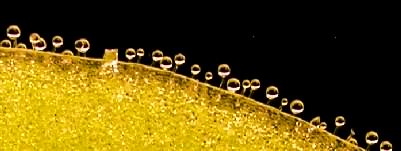
Close up of a Pinguicula gigantea leaf showing stalked glands tipped with dew. The dew is not produced on the actual leaf surface.
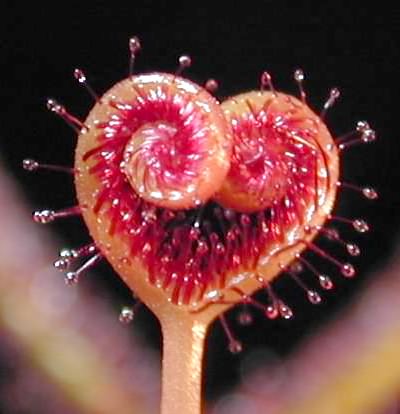
Drosera binata leaf opening. The fully open leaf is an effective adhesive trap with dewy tentacles.
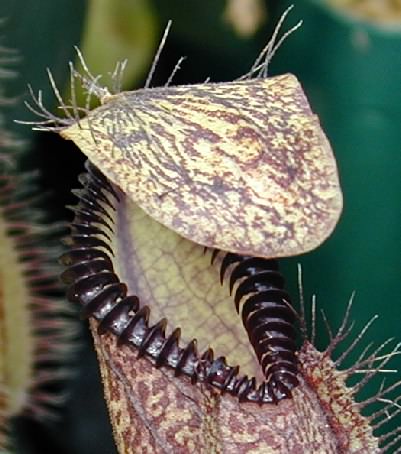
Nepenthes hamata leaf. This is an example of a pitfall trap with a pool of water at the bottom. Besides the "teeth" at the top of the pitfall the inner surface is covered with wax that fouls the feet of insects so they can't climb out. You can see nectar glistening between the "teeth". The trap also has nectar glands on the underside of the lid to attract prey which fall into the trap.
